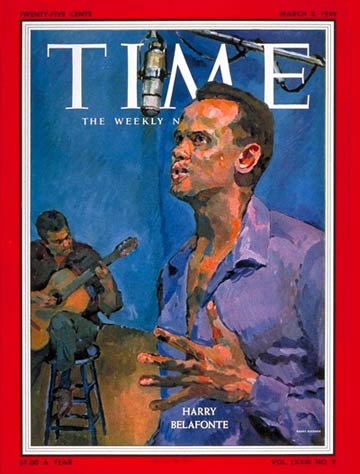
Harry Belafonte
The young man used to ride the New York subways with a pencil in his pocket and a chip on his shoulder. Sometimes, when he saw the placards for a cosmetic lotion urging straphangers to preserve the soft white beauty of their hands, he would take out his pencil and scrawl derisive comments: "How about Negro hands?" or "What if you're Chinese?" Car cards urging brotherhood and tolerance got the inscription: "There is bigotry in America." The girl who often rode with him would remonstrate, but the young man scarcely heard her. Even then, she recalls, "there was a storm within Harry."
A little more than a decade later, Harry Belafonte stands at the peak of one of the remarkable careers in U.S. entertainment. His own expressive, light brown hands—clenched in anger, or fanned in a kind of ineffable wonder, or carving an emotional tracery under the spotlights—are as familiar in the world's famed theaters and nightclubs and on U.S. TV as his husky voice. Instead of riding the IRT, Belafonte now has his choice of two Mercedes-Benzes; to the subway girl, who was his first wife, he was able to give a $10,000 platinum bracelet as a "divorce present" when their marriage broke up in 1957. Each of the seven albums he has recorded (for RCA Victor) has sold more than 200,000 copies, and one (Belafonte Sings of the Caribbean) became the first LP by a single performer to sell more than a million, a record since matched only by Elvis Presley. Belafonte's $700,000, five-year contract with the Riviera Hotel in Las Vegas guarantees him $140,000 for a minimum of four weeks a year, and he has received as much as $200,000 for appearing in a movie (Island in the Sun). This week he starts filming his own picture, Odds Against Tomorrow, in which he is involved both as co-star and producer (through his own company, HarBel Productions). He has even achieved that peculiarly null century sign of distinction, a regular weekday visit to a psychoanalyst. His second wife and his nine-year-old daughter (by his first marriage) are in analysis, too; his first wife has already been analyzed.
Valentino & Brando. Harry Belafonte's background is an arresting mixture of black and white ancestry, of Harlem harshness and the West Indian languor, of Broadway jazz caves, Greenwich Village hash houses, efficient modern recording studios. Throughout he has clung to a certain tough quality that can flash out as easily as his boyish smile. Recently TV Director Don Medford tried to define the key to Belafonte's dramatic magnetism: "Behind him is this hard core of hostility. Like Brando, Jimmy Dean, Rod Steiger, he's loaded with it." The quality lends a demon drive to Belafonte's career and immense conviction to his work. The minute he steps on the stage, he says, he tries by his manner to let his audience know: "I'll take no liberties with you and I hope you'll take none with me."
